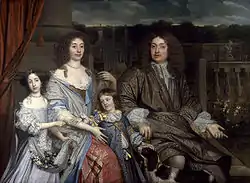Sir Robert Vyner, 1st Baronet
Sir Robert Vyner, 1st Baronet, (alternatively Viner) (1631 – 2 September 1688), Lord Mayor of London, was born in Warwick, but migrated in early life to London, where he was apprenticed to his uncle, Sir Thomas Vyner (1558–1665), a goldsmith-banker, was Lord Mayor of the City of London in 1674–1675.[1]

After moving to London, Robert soon became a partner in his uncle's business, and in 1666 was elected an Alderman of the City of London; in 1665 he was made a knight, and in the following year a baronet. He was sheriff during the year of the Great Fire of London, and was chosen Lord Mayor of the City of London in 1674. Combining like his uncle the business of a banker with that of a goldsmith, Viner, who produced the jewel-studded replica of the Crown of St. Edward and the King's Orb, used for Charles II's coronation in 1661,[2] was brought much into contact with Charles II and with the court. The king attended his mayoral banquet, and the Lord Mayor erected an equestrian statue in his honour on a spot now covered by Mansion House.[1]
Sir Robert bought Swakeleys House in Ickenham, west of London (near its outer edge, which has one open day per year) from the wife of Sir James Harrington soon after Harrington had fled to France in 1660. Following the banquet attended by Charles II, Samuel Pepys visited the house twice to borrow money on behalf of the king. Pepys recorded in his diary how Sir Robert had shown him the body of a black boy who had worked as a servant, but had died of consumption. The body had been dried in an oven and kept in a box, which would be shown to visitors.[3][4] Vyners School, a secondary school in Ickenham is named after Sir Robert.[5] In 1659 he served as High Sheriff of Norfolk.
Having been appointed the king's goldsmith in 1661, Sir Robert was one of those who lent large sums of money for the expenses of the state and the extravagances of the court; over £400,000 was owing to him when the national exchequer suspended payment in the move called the Great Stop of the Exchequer 1672, and he was reduced to the necessity of compounding with his creditors. He obtained from the state an annuity of £25,000.
Viner was a signatory to "The Several Declarations of The Company of Royal Adventurers of England Trading into Africa". This document was published in 1667 by the Royal Africa Company, which attempted to form a monopoly on the transatlantic slave trade in the late 1660s.[6][7][8]
Notes
- Chisholm 1911.
- SDt Edward's Crown; the King's Orb.
- "Thursday 7 September 1665", pepysdiary.com
- Hughes, Morris. W. (1983). The Story of Ickenham. Uxbridge: London Borough of Hillingdon. ISBN 0-907869-04-1.
- Bowlt, Eileen. M. (1996). Ickenham & Harefield Past. London: Historical Publications. ISBN 0-948667-36-2.
- Davies, K. G. (Kenneth Gordon) (1999). The Royal African Company. London: Routledge/Thoemmes Press. ISBN 0-415-19072-X. OCLC 42746420.
- Pettigrew, William A. (William Andrew), 1978-. Freedom's debt : the Royal African Company and the politics of the Atlantic slave trade, 1672-1752. Omohundro Institute of Early American History & Culture. Chapel Hill [North Carolina]. ISBN 978-1-4696-1183-9. OCLC 879306121.CS1 maint: multiple names: authors list (link)
- Aylmer, G.E. (25 September 2014). "Vyner [Viner], Sir Robert, baronet". Oxford Dictionary of National Biography.
References
- Welch, Charles (1899). . In Lee, Sidney (ed.). Dictionary of National Biography. 58. London: Smith, Elder & Co. pp. 366–268.
 This article incorporates text from a publication now in the public domain: Chisholm, Hugh, ed. (1911). "Viner, Sir Robert". Encyclopædia Britannica. 28 (11th ed.). Cambridge University Press. p. 97. This work in turn cites:
This article incorporates text from a publication now in the public domain: Chisholm, Hugh, ed. (1911). "Viner, Sir Robert". Encyclopædia Britannica. 28 (11th ed.). Cambridge University Press. p. 97. This work in turn cites:
- Viner: a Family History, published anonymously (1885).
Further reading
- Aylmer, G. E. (January 2008) [2004]. "Vyner , Sir Robert, baronet (1631–1688)". Oxford Dictionary of National Biography (online ed.). Oxford University Press. doi:10.1093/ref:odnb/28318. (Subscription or UK public library membership required.)
| Baronetage of England | ||
|---|---|---|
| New creation | Baronet (of London) 1666–1688 |
Extinct |